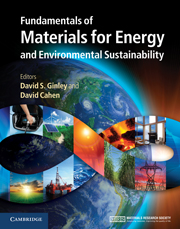Book contents
- Frontmatter
- Contents
- Contributors
- Preface
- Acknowledgments
- Part 1 Energy and the environment: the global landscape
- Part 2 Nonrenewable energy sources
- Part 3 Renewable energy sources
- Part 4 Transportation
- Part 5 Energy efficiency
- 35 Lighting
- 36 Energy efficient buildings
- 37 Insulation science
- 38 Industrial energy efficiency: a case study
- 39 Green processing: catalysis
- 40 Materials availability and recycling
- 41 Life-cycle assessment
- Part 6 Energy storage, high-penetration renewables, and grid stabilization
- Summary
- Appendix A Thermodynamics
- Appendix B Electrochemistry
- Appendix C Units
- Index
- References
39 - Green processing: catalysis
from Part 5 - Energy efficiency
Published online by Cambridge University Press: 05 June 2012
- Frontmatter
- Contents
- Contributors
- Preface
- Acknowledgments
- Part 1 Energy and the environment: the global landscape
- Part 2 Nonrenewable energy sources
- Part 3 Renewable energy sources
- Part 4 Transportation
- Part 5 Energy efficiency
- 35 Lighting
- 36 Energy efficient buildings
- 37 Insulation science
- 38 Industrial energy efficiency: a case study
- 39 Green processing: catalysis
- 40 Materials availability and recycling
- 41 Life-cycle assessment
- Part 6 Energy storage, high-penetration renewables, and grid stabilization
- Summary
- Appendix A Thermodynamics
- Appendix B Electrochemistry
- Appendix C Units
- Index
- References
Summary
Focus
The chemical industry is intimately linked with the realities of transformation of fossil fuels to useful compounds and materials, energy consumption, and environmental sustainability. The questions that concern us are the following: how can one minimize energy consumption in the chemical industry and reduce waste formation in chemical reactions, and can we transform this industry from one based primarily on petroleum to one that utilizes renewable feedstocks? In this chapter we will see how this “greening” of this major industrial and energy sector will require the use of catalysis and development of new catalysts.
Synopsis
Thomas Jefferson stated that “the earth belongs in usufruct to the living.” This premise is the basis of present recognition that, if the natural capacity of planet Earth to deal with pollution and waste is exceeded, then our lifestyle will become unsustainable. In this context, it is difficult to imagine life in the twenty-first century without accounting for the role the chemical industry plays in our modern society. For example, in the transportation sector, the most obvious aspect is the production of efficient fuels from petroleum, but one also should consider catalytic converters that reduce toxic emissions, and engineering polymers and plastics that reduce vehicle weight and therefore reduce fuel consumption. In daily consumer life we use chemicals in products such as paints, DVDs, synthetic carpets, refrigerants, packaging, inks and toners, liquid-crystal displays, and synthetic fibers. Pesticides and fertilizers are needed in order to increase agricultural productivity and pharmaceuticals to keep us healthy. In this chapter we will try to understand the aspects involved in the sustainability of the chemical industry. We will describe how to measure and control environmental performance and then define what we mean by green processing in the chemical industry, specifying green process metrics, introducing key concepts such as atom economy, E-factors, and effective mass yields. With these concepts together with the evaluation raw material costs, waste treatment, and unit processes needed for production of a chemical one can appreciate the “greenness” of a chemical process. The second part of this chapter will describe the role catalysis has in chemical transformations and how catalysis is used to reduce energy consumption and waste formation, together leading to increased sustainability. Examples will be given for a spectrum of applications ranging over oil refining, ammonia production, manufacture of important chemical intermediates and materials, and use of catalysis for the production of commodity chemicals. Finally, we will discuss the role catalysis may play in the replacement of fossil-fuel feedstocks with renewable ones, and how catalysis may contribute to our search for solar fuels.
- Type
- Chapter
- Information
- Publisher: Cambridge University PressPrint publication year: 2011



